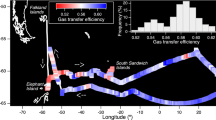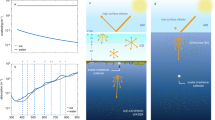Abstract
UNLIKE ices from pure or freshwater, sea ice is a highly permeable medium for gases. We have found that: (1) the migration of these gases along the grain boundaries (probably in brine channels) was 2 to 6 times as great as that at right angles to the principal axis of the grain boundaries; (2) the rate of penetration is ∼ 30 cm h−1 at −15 °C for halogenated gases (in nl ml−1 quantities) and 60 cm h−1 at −7 °C for carbon dioxide (in μl ml−1 quantities); (3) the vertical migration is about twice as fast as horizontal migration at −15 °C, and (4) for one experiment with a block of semi-fresh pressure ridge ice, the migration rate was ∼ 60 cm h−1 at −15 °C. The permeation constants are estimated to be 10−7 cm2 s−1 atm−1 at −15 °C for SF6, and 2 × 10−5 cm2 s−1 atm−1 for CO2 at −7 °C. These data strongly indicate that gas migration through sea ice is an important factor in ocean–atmosphere winter communication particularly when the surface temperature is > −10 °C.
This is a preview of subscription content, access via your institution
Access options
Subscribe to this journal
Receive 51 print issues and online access
$199.00 per year
only $3.90 per issue
Buy this article
- Purchase on SpringerLink
- Instant access to full article PDF
Prices may be subject to local taxes which are calculated during checkout
Similar content being viewed by others
References
Hemmingsen, E., Tellus, 11, 355–359 (1959).
Langham, E. J., Can. J. Earth Sci., 11, 1280–1287 (1974).
Raymond, C. P., and Harrison, W. D., J. Glaciol., 14, 213–233 (1975).
Eide, L. I., and Martin, S., J. Glaciol, 14, 137–154 (1975).
Wakahama, G., et al. Low Temp. Sci. A. 31, 209–220 (1973).
Author information
Authors and Affiliations
Rights and permissions
About this article
Cite this article
GOSINK, T., PEARSON, J. & KELLEY, J. Gas movement through sea ice. Nature 263, 41–42 (1976). https://doi.org/10.1038/263041a0
Received:
Accepted:
Issue Date:
DOI: https://doi.org/10.1038/263041a0



